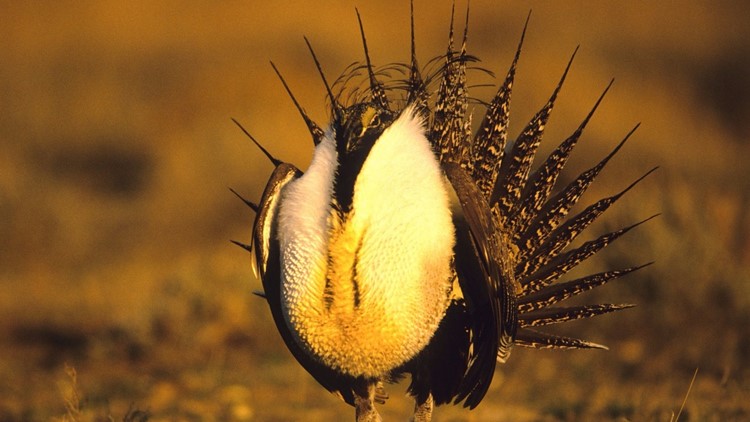CHEYENNE, Wyo. — A U.S. Forest Service plan released Friday would reduce designated sage grouse habitat in Wyoming and Nevada while easing grazing rules intended to protect the ground-dwelling birds in five Western states.
The plan would target 300 square miles now set aside for sage grouse in Wyoming and Nevada. Nearly all of the reduction would come in Wyoming, the state with the West's largest share of sage grouse in its wide, sagebrush-covered basins.
Supporters say the move would more closely align state and federal habitat designations.
Environmentalists, however, see it as the latest move by the Trump administration to ease obstacles for ranchers and energy developers in sage grouse habitat regions.
A plan released in March would make oil, gas and other development easier on 13,000 square miles of sage grouse habitat on lands controlled by the U.S. Bureau of Land Management. The change would allow more waivers for drilling in those areas.
More than 8,000 square miles of national forest land has been set aside as protected habitat for the birds on Forest Service lands in Colorado, Idaho, Nevada, Utah and Wyoming.
Other proposed Forest Service changes disclosed Friday include easing grass-height guidelines throughout that habitat, making them apply only when sage grouse conservation isn't working in areas being grazed by cattle and other livestock.
The Forest Service document describes the changes as a locally driven shift from a "one size fits all" approach to sage grouse protection.
Agriculture Secretary Sonny Perdue called it an example of "sharing stewardship" with Western states.
Environmental groups worry the changes could further imperil the chicken-sized bird known for its elaborate mating rituals. Sage grouse numbers have dwindled from an estimated 16 million before European settlement of the West to no more than 500,000 today.
The Natural Resources Defense Council says the proposed reduction "unravels" a 2015 Forest Service conservation plan.
The agency said then the birds would not be listed as threatened or endangered because state and federal agencies had come up with plans to conserve its habitat.
"It runs roughshod over sensible policy, science, and the natural resources we all, collectively, own," Bobby McEnaney, a director with the Natural Resources Defense Council, said about the proposed changes.
Bob Budd, state sage grouse planner in Wyoming, said the boundary changes would align Forest Service plans with Wyoming's map of state-designated sage grouse habitat, removing areas that aren't being protected.
"It lines up almost perfectly with our strategy. The acres that were changed were acres that were probably erroneous earlier," Budd said.
Many of the changes, however, water down conservation rules to mere guidelines instead of standards, said Erik Molvar with Western Watershed Project.
For example, prohibiting more than one disruptive activity per square mile in sage grouse habitat would change from a standard to a guideline.
"The only ones that are legally enforceable and hold any water are the standards," Molvar said.
The release of the plan opens a 60-day period for people to raise objections and a 90-day period for the Forest Service to respond to objections. A final decision on whether to implement the plan could be made late this year or in early 2020.



